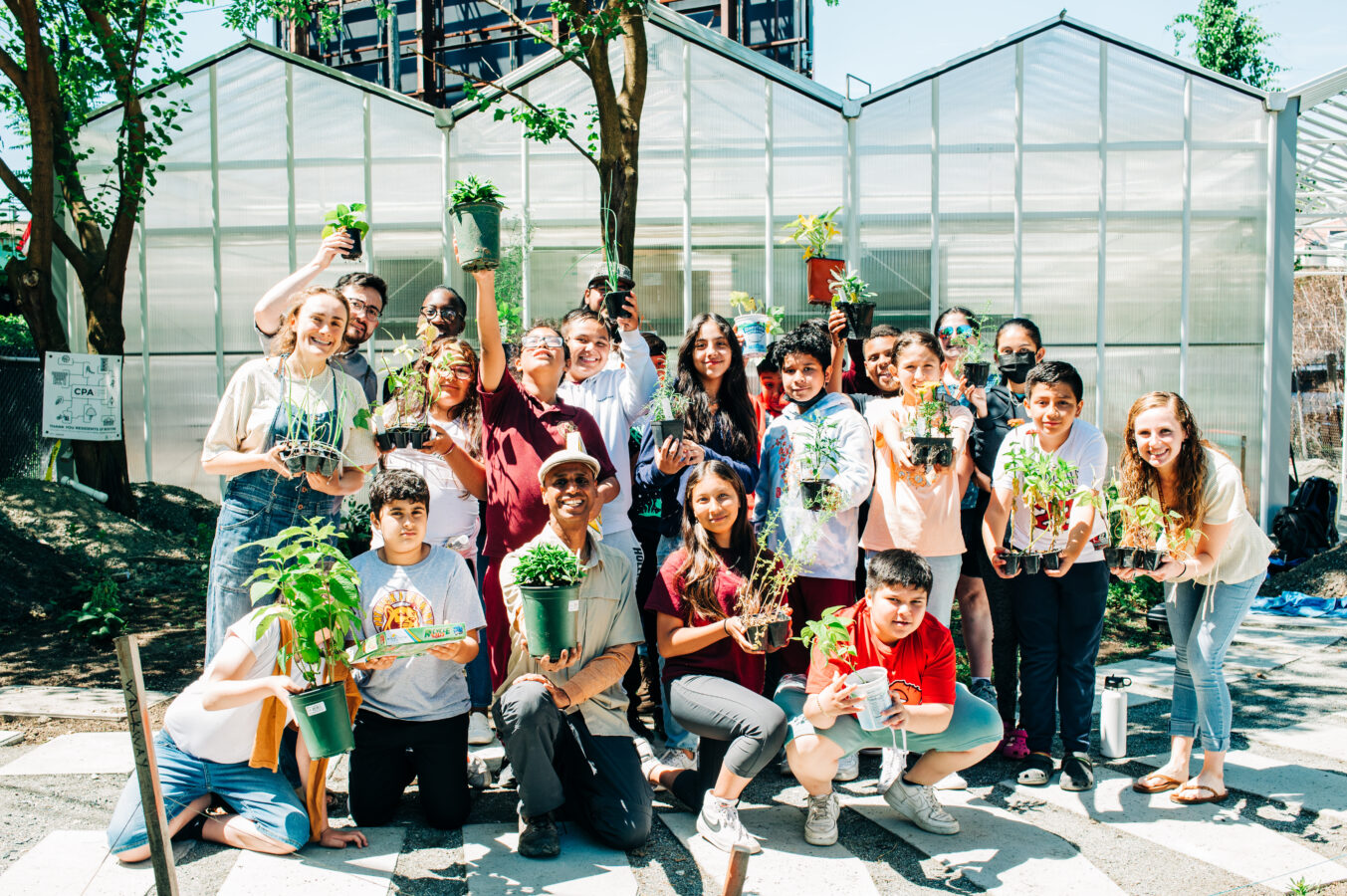It was a cold November day in Boston, and I rushed from a conference on public health to tour Eastie Farm. Founded in 2015 on a single lot in East Boston, this urban farm has expanded to seven sites and is working to build climate adaptation and mitigation into urban farming, while offering education, green job training, green space, community gathering space, and affordable locally and regionally grown food. They are also innovators who just finished building the first geothermal greenhouse in the region. After the tour, I had the pleasure of speaking with founder Kannan Thiruvengadam and Jenny Wechter, who heads up climate work for the Eastie Farm team.
Eastie Farm is one of thousands of local organizations transforming the US food system—exactly the type of organization my colleagues and I at the Union of Concerned Scientists (UCS) want to see uplifted in the 2023 farm bill. We hope you take not only inspiration from this conversation, but also action to support the work of Eastie Farm and similar organizations, and to advocate for policy changes that promote sustainability and equity in our food and farm system.
You’ve expanded since the beginning, both in acreage and programming. What motivated you in 2015, and how has your thinking about Eastie Farm’s role in the community evolved since then?
KT: What motivated me was really trying to find a grounded climate action that has ongoing benefits. My dad is a farmer in India. Even though I’ve been a computer guy most of my professional life, as soon as I learned about climate change, I left my tech world to work on climate and community. I eventually ended up in permaculture and was looking for a project where people can benefit in the here and now while also creating a space where we can sow the seeds for a livable future. Today at Eastie Farm, we are creating opportunities for people to do exactly that: connect with each other and act on climate change. Then we will be in a better position to support each other as climate change unfolds, because, as we learned from COVID, crises affect different people differently, and those of us less affected can support the more affected.
We are trying to solve a global problem, but a small local problem seems challenging enough. If we’re successful at that, we can take on larger challenges. My thinking has evolved over the past several years. Now it’s more about why the most impacted people are not involved in climate so much. It’s because they have more ongoing worries. Think about people who are struggling to make ends meet, who have kids, maybe healthcare issues, immigration issues. Climate cannot be on top of their mind.
I’ve come to understand that by living in a community that is a microcosm of injustice in the world—in its demographics, geographical location, history. We, the community of East Boston, are an environmental and climate justice community. We’ve been ignored for a long time from an economic perspective. There are a lot of abandoned lots I wanted to convert into something positive, while working together with other neighbors.
JW: When I think of how the Union of Concerned Scientists relates to Eastie Farm and our mission, I think there needs to be a union of inspired citizens. I think that’s what’s missing from the table. There must be a basis of people that are not only able to receive what you at UCS are sharing but are also inspired to take action, and that’s what we are doing at Eastie Farm. We are trying to create a basis, a union of inspired people who are connected not only to the problem, but also knowing where the solutions are, seeing them in action, and seeing how they can be a part of it.
Eastie Farm is not simply an urban farm, but a holistic response to structural racism in East Boston. Can you share a bit about how your work addresses the interconnected issues of environmental justice, climate justice, economic justice, and food justice?
KT: By expanding in all possible ways to help and uplift the people who are most impacted by racial injustice. You have to work beyond the boundaries of the establishment in order to address the concerns of marginalized people because, by definition, they are beyond the boundaries of who the system is willing to help and support.
During COVID it was the community organizations that stepped up to do the work when governments seemed stunned. Eastie Farm and other organizations like us stepped up to do everything that was needed, using all the creativity we could muster and making it more than a full-time job for ourselves because we are close to the pain. Being that close to the pain and feeling that pain means we know exactly what needs to be done.
In our community is the Latinx population and the North African population. During COVID, we employed people from the very communities we were trying to support. This meant they didn’t feel like they were getting handouts. Instead, they were being involved in a meaningful way that actually uplifts them and benefits the community.
We also de-stigmatized food insecurity: our community-supported agriculture (CSA) program is for the entire community, which means it includes people who can afford the market rate and those who can’t. People can come and claim their CSA without anybody knowing their economic status. We saw an uptick in collection after we made that possible.
JW: Education is a big part of it too. Eastie Farm already does a lot of education in the community, from teaching kindergarteners in our gardens to employing high school teens in an earn-to-learn green job program. For justice to be cultivated, the people who are most affected by injustice have to be informed about the problems and also empowered to act on them. What I want to see is all children learning about climate change and how it relates specifically to East Boston, their own community. I want to see kids going outside with their teachers and learning about how kale is growing, and harvesting onions, and whatever else is growing. And then seeing those vegetables, those plants they helped grow, in their school lunches, rather than pizza that was made 300 miles away and frozen. Good, fresh food for these kids—food that makes them feel good and healthy and ready to learn—that’s a critical piece of the equity work.
 Kannan Thiruvengadam (front row, third from left) and Jenny Wechter (far right) pose with students from Patrick J. Kennedy Elementary School in front of Eastie Farm’s geothermal greenhouse. (Credit: Eastie Farm/Agnieszka Rytych-Foster)
Kannan Thiruvengadam (front row, third from left) and Jenny Wechter (far right) pose with students from Patrick J. Kennedy Elementary School in front of Eastie Farm’s geothermal greenhouse. (Credit: Eastie Farm/Agnieszka Rytych-Foster) One of the unique aspects of Eastie Farm is the geothermal greenhouse you built during the COVID-19 pandemic. How did the greenhouse come about, and what role does it play in the community?
KT: The geothermal greenhouse is in a central location in the neighborhood and it’s very accessible for food distribution and education and bringing people together. We’ve had CSA potlucks and I see that it’s a joyful space. In the wintertime, you’re in this bright-colored, warm space with plants, a space that doesn’t have the negative health impacts of natural gas or propane burning.
Locally grown food is another direct benefit. When people understand and appreciate fresh local food, they make healthier choices and spend less on doctors and hospital fees. And people get to learn more about climate action because the zero-emissions greenhouse is a living example. This is a climate justice community: it has contributed the least to climate change, it is able to do the least to mitigate climate change, yet it will be affected the most and earliest by climate change. Normally, things like this don’t happen in environmental justice neighborhoods, but we’ve made the first geothermal greenhouse in the region happen here.
Eastie Farm has so many different roles in the community and these roles keep expanding. What helps you with this work, and what are the barriers to this work?
KT: What helps us do the work are people like Jenny—caring, compassionate, and creative folks. I am also inspired by this community’s resilience throughout its history of injustices.
Inertia is one barrier. People often say things like, “That’s what we’ve done so far,” suggesting that should be what we continue to do, but we don’t question ourselves about why we’ve done what we’ve done and why we are where we are. Inertia is a big barrier to individuals, the community, and society at large.
Finally, funding is another barrier. People assume if you have an organization, you must have funding. We have an organization because we realize we have work to do, and then we go and figure out the funding. We have no ongoing funding from anywhere. Yet we need to function in an ongoing manner, we need to pay people in an ongoing manner. We have great positive impact in terms of food security, climate resilience, and education, but without ongoing support, we can’t sustain such impact.

 1 year ago
75
1 year ago
75


